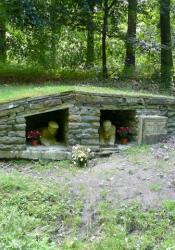Huskar Pit Disaster
The Huskar Pit Disaster (also known as the Huskar Colliery Tragedy of 1838) was a terrible event that illustrates the horror children faced working in coal mines. First off, we must understand what coal mines were like. Coal mines were deep pits. They were usually around 300 feet underground. Huskar Pit was used as ventilation for the miners. Whole families often worked in the mines together. Children worked as trappers, hurriers, and thrusters, helping to bring the coal from the rock face to the surface by carts and passageways. While women worked as hurriers, most often. Trappers sat in the dark and waited for the carts to come pulled by the hurriers. Trappers also kept the mine ventilated. Hurriers were strapped to the carts and pushed and pulled them along the passageways until they reached the surface. Thrusters pushed from behind. They kept the cart moving. These were the roles children had within coal mines.
The roles of children in coal mines are already horrific, yet on July 4, 1838, 26 children lost their lives. That day was a fairly typical day until the early afternoon. A storm blew in and brought with it rainfall and hail. In this specific coal mine, there was a steam engine which brought the coal and the workers up from the pit. The rain doused the boiler, and the engine was unable to work. The many adult workers moved down to the bottom of the pit where they were to most safe until they could be brought up. The children, both boys and girls, waited for the engine to start again. They heard a thunderclap and were afraid something had exploded in the mine. They had been down in the mines for nine hours already, so they became desperate to save themselves. They decided to take the Huskar Pit ventilation drift out. They climbed it and reached an air door. Outside the door, the rain had caused a small stream to bulge and grow to an abnormal size. The children were unaware of the increasing water. They pushed the door open and were soon washed down the drift. They drowned. 26 children died that day, eleven girls and fifteen boys. When this incident was told to Queen Victoria, she took great interest in it, and it led to the Royal Commission which investigated women and children's labor in coal mines.
They have the names of each child that died. I have included them here to help make them a little more real:
Catherine Garnett 11 years
Hannah Webster 13 years
Elizabeth Carr 13 years
Ann Moss 9 years
Elizabeth Hollings 15 years
Ellen Parker 15 years
Hannah Taylor 17 years
Mary Sellors 10 years
Elizabeth Clarkson 11 years
Sarah Newton 8 years
Sarah Jukes 10 years
George Birkinshaw 10 years
Joseph Birkinshaw 7 years
Isaac Wright 12 years
Abraham Wright 8 years
James Clarkson 16 years
Francis Hoyland 13 years
William Atick 12 years
Samuel Horne 10 years
Eli Hutchinson 9 years
George Garnett 9 years
John Simpson 9 years
George Lamb 8 years
William Wormersley 8 years
James Turton 10 years
John Gothard 8 years
"Huskar Colliery 1838." Mine Accidents and Disasters. Mining Accident Database. 2021. http://mineaccidents.com.au/mine-accident/202/huskar-colliery-1838
"The Huskar Pit Disaster." The Penistone History Archive. 2018. https://penistonearchive.co.uk/huskar-pit-disaster/

